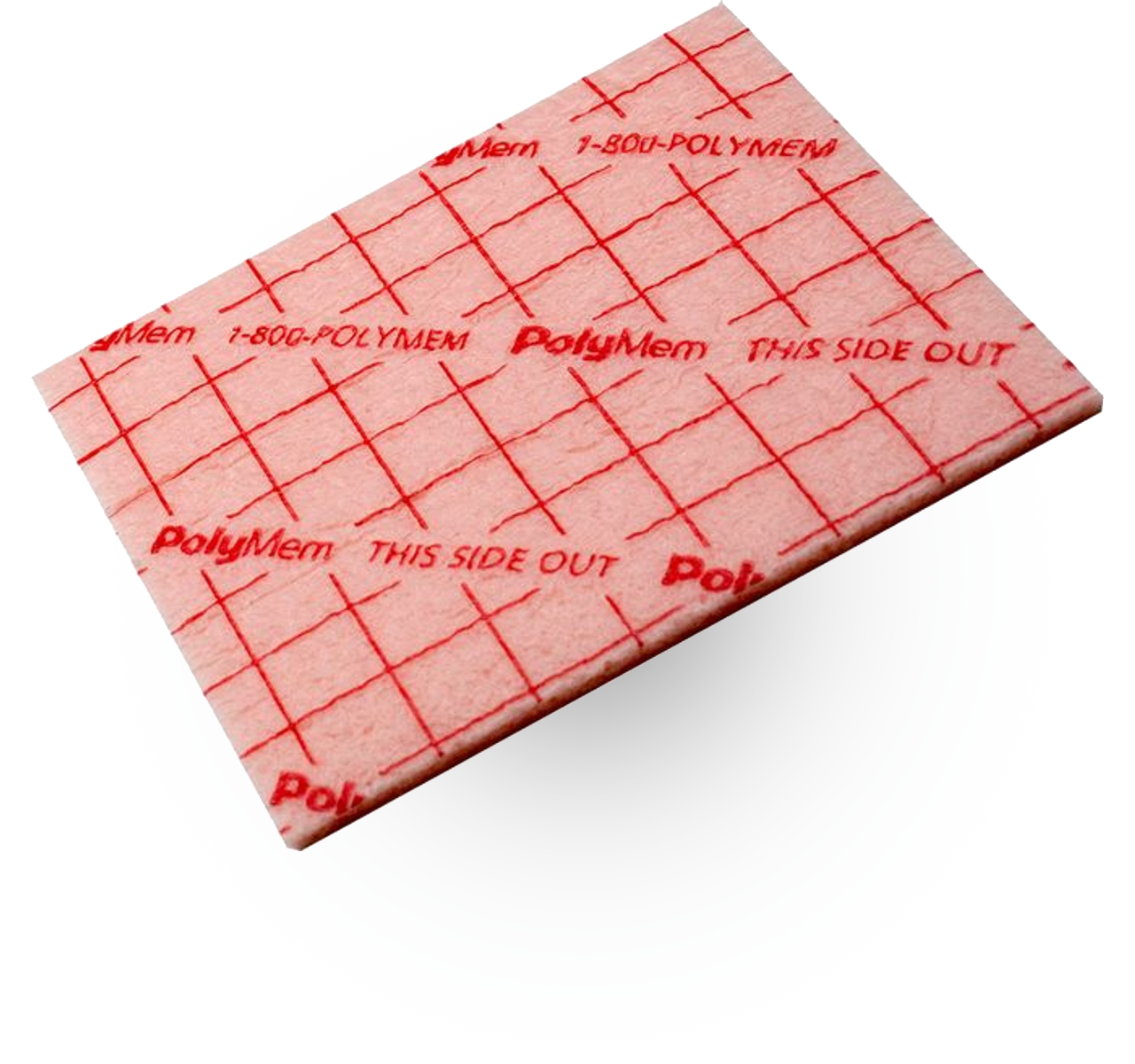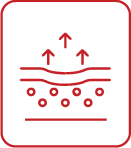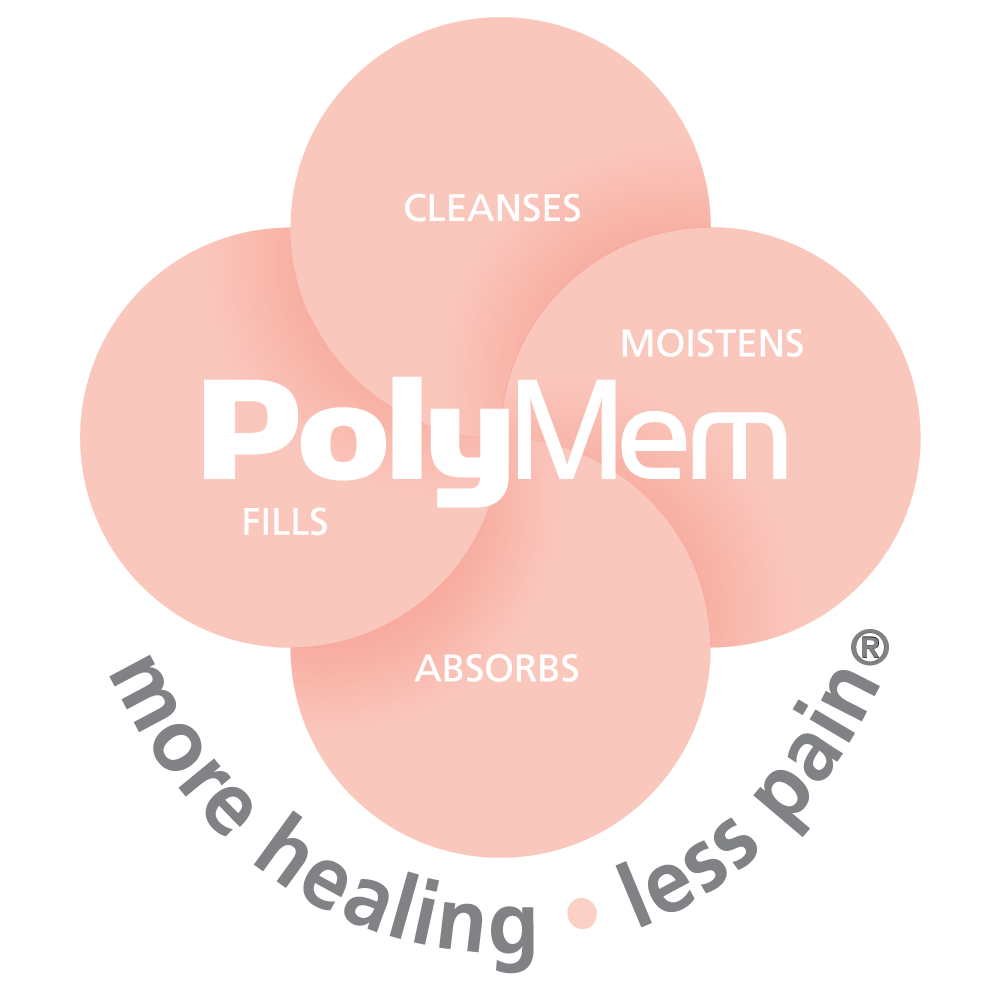
One dressing | All wound types | Simple solution
Multifunctional wound dressing
Designed to actively stimulate wound healing and provide pain relief associated with wounds. The unique therapeutic wound management system is easy to use and streamlines wound care for the benefit of both patients and healthcare providers.
Patients experience rapid wound healing, shorter treatment times, and pain relief. Healthcare providers benefit from a cost-effective wound care system that accelerates wound healing, reduces the time spent on wound care, and simplifies the selection and usage of dressings.

The Components
PolyMem wound dressings consist of a polyurethane matrix containing surfactant, glycerin, and superabsorbent co-polymer. All dressings, except for the WIC cavity dressings, have a semi-permeable outer layer.
Each of these five components is carefully selected for its specific function and, most importantly, because together they create a unique synergy that makes PolyMem a truly exceptional therapeutic wound care system. The ability to concentrate the inflammatory response around the tissue injury/wound accelerates the wound healing process. At the same time, the spread of inflammatory cells to the surrounding healthy tissue is reduced, minimizing secondary tissue damage. The activity of nociceptive nerve endings is decreased, resulting in minimized edema formation and reduced pain signals to the brain.
The unrivaled benefits
With the unique therapeutic wound care system, the following can be observed:

controls inflammation
- Accelerated autolytic debridement
- Reduction in micro-edema and increased blood perfusion

improves healing
- Formation of new capillaries
- Improves migration of epithelial tissue

Reduces pain and swelling
- Reduced nociceptive activity: reduction in edema and hematoma formation in the surrounding tissue
- Relief of wound pain.
Product Information
Detailed product list for easy ordering
Product Selector
Find the ideal dressing for any wound.

5 Mechanisms of Action
1. Surfactant
Surfactant is a gentle, non-ionic, and non-toxic substance that becomes active in the presence of moisture, steadily releasing onto the wound bed. Its purpose is to decrease the tension between healthy and non-viable tissue, facilitating the gentle removal of non-viable tissue. This cleansing process is performed without trauma, potentially reducing or even eliminating the need for additional wound care or debridement. The surfactant is continuously released, actively cleansing the wound throughout the entire wearing period.
2. Glycerol
Glycerin, when activated by moisture, is released onto the wound bed and skin, providing a soothing, protective, and nourishing effect. It plays a crucial role in maintaining an ideal moisture balance in the wound and forms a protective barrier on the skin, enhancing its health, elasticity, and overall strength post-healing. Glycerin creates a film between the dressing and the wound, allowing for a gentle and painless removal of the dressing. Moreover, glycerin helps reduce unpleasant odors associated with wound care.
3. Polymeric Membrane Matrix
The polyurethane matrix used in the dressings is a hydrophilic material with a unique cell structure, enabling a capillary effect. Working in conjunction with the superabsorbent co-polymer, it facilitates a gentle capillary action that draws fluid from the deeper layers of tissue to the surface of the wound. This helps reduce micro-edema in and around the wound where the dressing is applied while promoting improved blood circulation. Furthermore, along with tissue fluid, vital nutrients and growth factors are brought up to the wound bed, supporting tissue regeneration. When the matrix becomes moist, the dressing expands, allowing it to conform to the contours of the tissue and establish close contact with the wound bed.
4. Superabsorbent
The superabsorbent co-polymer possesses a strong attraction to water molecules, allowing it to selectively draw out the aqueous component from wound exudate. As a result, the concentration of nutrients and growth factors in the wound bed is elevated. The superabsorbent material efficiently absorbs and binds wound exudate, debris, and bacteria within the dressing, which are subsequently removed when the dressing is changed. This capability to retain wound exudate within the dressing reduces the risk of leakage and maceration, making PolyMem an excellent choice for compression therapy.
5. Optimal MVTR transparent film
With the exception of cavity dressings, all PolyMem dressings incorporate a semi-permeable film. This breathable film plays a crucial role in managing fluids while simultaneously safeguarding the wound against external contaminants. The film on PolyMem Standard has a lower breathability (MVTR – Moisture Vapor Transmission Rate) compared to the film on PolyMem MAX.


Office and Distribution Centre
Unit 2, 195 Chesterville Road
Moorabbin VIC 3189, Australia